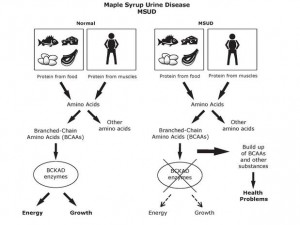

Administration of IV BCAA-free solution at the beginning of a DE could reverse depletion of the amino acids that compete with BCAAs for the LAT1 transporter, and the observed depletion of alanine, despite IV alanine supplementation. The duration of administration ranged from 3–20 days. Leucine normalization was achieved in all cases with resolution or improvement of clinical symptoms following IV BCAA-free solution. Clinical evolution, amino acid profile and adverse effects were evaluated.ResultsWe evaluated the use of BCAA-free solution in 5 DEs in 5 MSUD pediatric patients, all with significantly elevated plasma leucine levels at admission (699–3296 μmol/L) and in 1 episode of risk of DE due to surgery.
#Maple syrup urine disease series#
This pediatric series discusses the management of DEs in MSUD patients with IV BCAA-free solution, as an emergency treatment for DEs or as a prophylactic in cases requiring surgery. Intravenous (IV) administration of BCAA-free solution could represent a powerful alternative for emergency treatment of decompensations.Methods These episodes require immediate intervention to prevent irreversible neurological damage. Metabolic decompensation episodes (DEs) in Maple Syrup urine disease (MSUD) result in brain accumulation of toxic branched-chain amino acids (BCAAs) and their respective branched-chain α-keto acids that could induce neuroinflammation, disturb brain bioenergetics, and alter glutamate and glutamine synthesis. However, as extracorporeal techniques may cause infection, increased catabolism and require an appropriately equipped facility and experienced personnel, the management of DE with non-invasive effective nutritional interventions is an attractive option, and has been shown to be effective in previous cases (14). In instances where this treatment is inadequate or insufficiently effective, especially in the pediatric population, or when leucine plasma levels are critically elevated and associated with severe clinical symptoms, extracorporeal procedures, including haemodialysis (HD) and/or haemofiltration (HF) are necessary to prevent neurotoxicity and death (7, 8,12). In the absence of standardized approved treatments, the common approach for managing DE generally involves increasing the BCAA-free amino acid formula, usually via a nasogastric tube (7,12), decreasing or stopping leucine intake, supplementing valine and isoleucine (20-120mg/kg/day), providing sufficient caloric and fluid intake to guarantee anabolism (1.5-3-times estimated energy expenditure (5,13). We review this disorder including its presentation, screening and clinical diagnosis, treatment, and other relevant aspects pertaining to the care of patients. Newborn screening for MSUD is now commonplace in the United States and is included on the Recommended Uniform Screening Panel (RUSP). Clinical outcomes are generally good in patients where treatment is initiated early. Treatment consists of dietary restriction of BCAAs and close metabolic monitoring.

The classic presentation occurs in the neonatal period with developmental delay, failure to thrive, feeding difficulties, and maple syrup odor in the cerumen and urine, and can lead to irreversible neurological complications, including stereotypical movements, metabolic decompensation, and death if left untreated.

The disorder varies in severity and the clinical spectrum is quite broad with five recognized clinical variants that have no known association with genotype. Maple syrup urine disease (MSUD) is an inborn error of metabolism caused by defects in the branched-chain α-ketoacid dehydrogenase complex, which results in elevations of the branched-chain amino acids (BCAAs) in plasma, α-ketoacids in urine, and production of the pathognomonic disease marker, alloisoleucine.


 0 kommentar(er)
0 kommentar(er)
